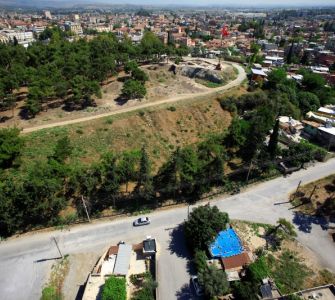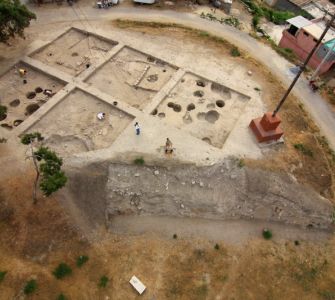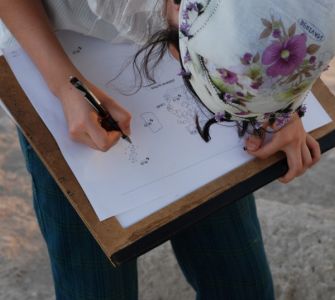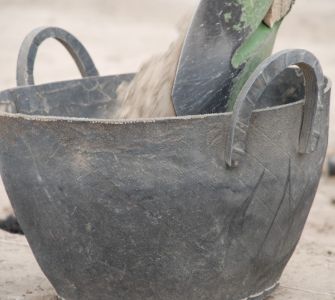Hills consisting of layers of old settlements in Anatolia are called Höyük (mound) among the people. The most important feature sought for a settlement in the early ages was security and being close to streams. One of the most important reasons why the 9000-year-old Gözlükule Mound is preferred as a settlement is that it is the only elevation in the city center of Tarsus. It was chosen as a settlement to be protected from the floods of Tarsus (Berdan) Stream.
When the first settlement was destroyed/abandoned due to various disasters, wars, epidemics or other reasons, the people who came later reorganized this area, which was the most suitable for settlement, and built a new settlement on it, rather than looking for another place. In this way; In Tarsus, which has been a popular settlement throughout history with its location close to the Gülek Strairt and its natural harbor, Gözlükule has developed as 33 floors.
It is stated that Cleopatra came to Tarsus, through the Regma Lagoon, which was a natural port connected to the sea at that time and the people enthusiastically greeted from Gözlükule Höyük.
Emperor Justinian, changed bed of the river in order to protect the city from floods and Regma Lagoon lost its port feature and became a swamp.
During the Roman Empire, the city center of Tarsus shifted to the north, and Gözlükule became a suburb.
Since the medieval settlements were located at the top of the mound, it was destroyed by treasure hunters and natural causes.
Gözlükule Excavation
The first excavations were carried out by the British consul Berker in 1845, followed by the French historian and author of the Old Cilicia book, Chales Victor Langlois. The figurines and seals found in these excavations were abducted and are exhibited in the Louvre Museum and the British Museum.
The first major excavations in the Höyük were initiated under the direction of Hetty Goldman in 1934, with the help of some organizations from America, with the instruction of Atatürk. As a result of the excavations, 33 layers were found from the Polished Stone Age to the Islamic period.
During the excavations, some streets and mudbrick houses, and finds known as Cilician Pottery and Mesopotamian Mosaic were unearthed. In addition, hieroglyphic and cuneiform seals and seal impressions were found.
Very important artifacts such as the seal belonging to Puduhepa, who was the wife of the Hittite King Hattusili the 3rd and signed the Treaty of Kadesh, and the seal impression of the Kizzuwatna King İspitahsu were found in these excavations and are exhibited in the Adana Archeology Museum.
The findings of the excavation results were published by Princeton University Publishing House in three volumes and it is accepted as one of the most important works that illuminate the prehistoric Anatolian archeology.
Machteld James Mellink, one of the most important names in Anatolian Archeology, and a team from Boğaziçi University History Department started the new period excavations in 2001. The excavations, which started again in 2007 under the leadership of Professor Aslı Özyar from Boğaziçi University, are still continuing.
Where is Gözlükule Höyük? Directions Information. How to Get to the Höyük?
The Gözlükule Mound is located in the Caminur Neighborhood, in the southern part of Mersin's Tarsus District, also known as Old Tarsus.
To go to Gözegule by private car from Mersin, after reaching Tarsus by using the Mersin-Adana highway you should follow the signs in the district.
In order to reach here by using public transport, after reaching Tarsus by bus or train, it is necessary to use public transport in the city.
Places to be seen around Gözlükule Höyük
Gözlükule Höyük is at the center of old Tarsus. Makam Mosque, Ulu Mosque, Kırkkaşık Bedesten , Kubatpaşa Madrasah, Saint Paul Church, Cleopatra Gate, Tarsus Museum, Ancient Roman Road, St. Paul's Well, and Old Tarsus Houses are all within walking distance. Our advice to visitors who come Tarsus by private vehicle, to leave their vehicles in a suitable place and visit all these points on foot. They will have had a pleasant time full of history from the ancient period to Turkish Republic.
Other nearby touristic spots:
Tarsus Waterfall: 3 km
Nusret Minelayer Culture Park:1 km
Tarsus Zoo: 7.5 km
Eshabı Kehf Cave: 14 km
Taşkuyu Cave: 14 km
Sağlıklı Roman Road: 20 km









